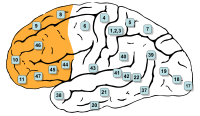
Photo from wikipedia
Musical score reading and word reading have much in common, from their historical origins to their cognitive foundations and neural correlates. In the ventral occipitotemporal cortex (VOT), the specialization of… Click to show full abstract
Musical score reading and word reading have much in common, from their historical origins to their cognitive foundations and neural correlates. In the ventral occipitotemporal cortex (VOT), the specialization of the so-called Visual Word Form Area for word reading has been linked to its privileged structural connectivity to distant language regions. Here we investigated how anatomical connectivity relates to the segregation of regions specialized for musical notation or words in the VOT. In a cohort of professional musicians and non-musicians, we used probabilistic tractography combined with task-related functional MRI to identify the connections of individually defined word- and music-selective left VOT regions. Despite their close proximity, these regions differed significantly in their structural connectivity, irrespective of musical expertise. The music-selective region was significantly more connected to posterior lateral temporal regions than the word-selective region, which, conversely, was significantly more connected to anterior ventral temporal cortex. Furthermore, musical expertise had a double impact on the connectivity of the music region. First, music tracts were significantly larger in musicians than in non-musicians, associated with marginally higher connectivity to perisylvian music-related areas. Second, the spatial similarity between music and word tracts was significantly increased in musicians, consistently with the increased overlap of language and music functional activations in musicians, as compared to non-musicians. These results support the view that, for music as for words, very specific anatomical connections influence the specialization of distinct VOT areas, and that reciprocally those connections are selectively enhanced by the expertise for word or music reading.
Journal Title: NeuroImage
Year Published: 2020
Link to full text (if available)
Share on Social Media: Sign Up to like & get
recommendations!